
If you have started shopping for a monopod or a tripod you’re probably feeling a little bit dazed and confused aren’t you? If you are, you
should check out these two blog posts first How to choose a tripod and Choosing a tripod head then read this one last. Once you decide on which type of head and which type of locking mechanism you want you will need to choose what material it’s made of. Currently there seem to be only two key materials being manufactured, aluminum and carbon fiber plus basalt. [Gitzo, used to make a tank of a tripod out of steel (?) which lasted FOREVER, but it is not clear whether or not you can buy them new anymore.] So what’s the difference? The top of the line right now is carbon fiber, it is lighter, stiffer and absorbs vibration more than the other two. Next in line is basalt (but it seems like only Gitzo is making this) and then there’s aluminum. In other words aluminum is the heaviest, less stiff and feels more vibration than the other two. The only other difference is price. Carbon fiber being the most expensive, and aluminum being the cheapest.
Having said this, if you are strictly looking to reduce weight, do your homework! sometimes carbon fiber does not give you a lighter weight unit when comparing apples to apples. For instance if you look at an aluminum vs carbon fiber monopod of the same size you will find that the weight difference is marginal. However the price is up to 5x more. However if you are considering a full length (5ft +) tripod, a carbon fiber version may be considerably lighter; this depends on the manufacturer, the head and the other parts that they use which may or may not help you save on weight.
Fundamentally all photographers (except studio photographers) are concerned with weight, as we or an assistant is carrying it, and who wants to carry more weight around? But before you head into a carbon fiber tripod you must also consider this. The reason you need a tripod is for stability. For instance you are doing a long exposure (aka night photography) or you are using a particularly big 1000mm lens etc. The problem with a light weight tripod is that it is light weight. Although carbon fiber is stronger than aluminum and will absorb ground vibration better (all good), if it is not big and beefy it is prone to being knocked over by you or a stiff wind. Or simply move because of wind. All of which defeats the purpose of a light weight tripod. So in the end we think it's likely a wash, as to whether you are really saving any weight by going with carbon fiber. Sorry folks.
